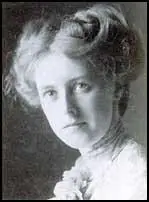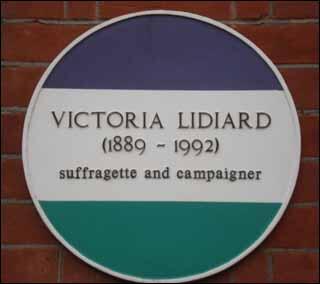Victoria Lidiard

Victoria Simmons, one of twelve children, was born in Clifton, on 23rd December 1889. Her father was a furniture dealer and held traditional views about the role of women. However, her mother had progressive opinions on politics and religion and as a girl she became a vegetarian.
Victoria went to a Dame School and later recalled "spending a great deal of time standing in the corner for asking too many questions". After leaving school at 14 she found work in a photographic studios in Clifton.
In 1907 Victoria and her mother attended a meeting held by Annie Kenney, the recently appointed West of England organiser of the Women's Social and Political Union (WSPU). As a result of hearing Kenney speak, both women joined the WSPU. Over the next couple of years, Victoria made regular speeches in Bristol on women's suffrage. During this period she became friendly with Mary Blathwayt, Mary Allen, Vera Wentworth and Elsie Howey. According to Bella Hoffman: "Most of her suffrage work was done in her home town, Clifton, Bristol. She chalked pavements; sold Votes For Women (and was spat on by a local clergyman for so doing); addressed meetings at Bristol Docks from the back of a lorry; and was told by a docker to get back to the kitchen and the bedroom where she belonged."
During the summer of 1908 the WSPU introduced the tactic of breaking the windows of government buildings. On 30th June suffragettes marched into Downing Street and began throwing small stones through the windows of the Prime Minister's house. As a result of this demonstration, twenty-seven women were arrested and sent to Holloway Prison. During this period Victoria was reluctant to get involved in violent demonstrations.
Emmeline Pankhurst decided that the WSPU needed to intensify its window-breaking campaign. On 1st March, 1912, a group of suffragettes volunteered to take action in the West End of London. The Daily Graphic reported the following day: "The West End of London last night was the scene of an unexampled outrage on the part of militant suffragists.... Bands of women paraded Regent Street, Piccadilly, the Strand, Oxford Street and Bond Street, smashing windows with stones and hammers."
On 4th March, the WSPU organised another window-breaking demonstration. This time the target was government offices in Whitehall. Victoria travelled to London from Bristol to take part in the demonstration. The severely disabled, May Billinghurst, agreed to hide some of the stones underneath the rug covering her knees. According to Votes for Women: "From in front, behind, from every side it came - a hammering, crashing, splintering sound unheard in the annals of shopping... At the windows excited crowds collected, shouting, gesticulating. At the centre of each crowd stood a woman, pale, calm and silent."
Victoria broke a window at the War Office. She later recalled: "He just looked at me. Meantime another policeman rushed up towards me and then an inspector on horseback came. So I was escorted to Bow Street, a policeman each side of me, clutching my arm. and one behind. Well, I had eight stones, but I'd only used one so on the way to the police station I dropped them one by one and to my amazement when I was taken down at Bow Street, this policeman that had followed put the seven stones on the table and said, She dropped these on the way." Victoria was one of 200 suffragettes who was arrested and jailed for taking part in the demonstration.
Victoria got two months. Bella Hoffman has pointed out: "Her memory of Holloway was of one of her own sisters shouting encouraging messages from across the street, standing on a chair in her cell and singing out of the barred window, and the black beetle in her porridge." Under instructions from her mother, Victoria did not go on hunger-strike. As she later pointed out in a BBC interview, although she was willing to go to prison for women's suffrage, she was unable to disobey an order given by her mother.
On 4th August, 1914, England declared war on Germany. The leadership of the WSPU began negotiating with the British government. On the 10th August the government announced it was releasing all suffragettes from prison. In return, the WSPU agreed to end their militant activities and help the war effort.
Emmeline Pankhurst announced that all militants had to "fight for their country as they fought for the vote." Ethel Smyth pointed out in her autobiography, Female Pipings for Eden (1933): "Mrs Pankhurst declared that it was now a question of Votes for Women, but of having any country left to vote in. The Suffrage ship was put out of commission for the duration of the war, and the militants began to tackle the common task."
After receiving a £2,000 grant from the government, the WSPU organised a demonstration in London. Members carried banners with slogans such as "We Demand the Right to Serve", "For Men Must Fight and Women Must work" and "Let None Be Kaiser's Cat's Paws". At the meeting, attended by 30,000 people, Emmeline Pankhurst called on trade unions to let women work in those industries traditionally dominated by men.
Victoria went along with this policy and during the First World War she and her sister ran a guest-house in Kensington for professional women, and made anti-aircraft shells at Battersea Power Station at the weekends. In 1918 she married Major Alexander Lidiard, of the Fifth Manchester Rifles. They had met while she was selling Votes For Women. He became a supporter of women's suffrage and was an active member of Men's League For Women's Suffrage.
After the war Victoria Lidiard trained as an optician and ran practices with her husband in Maidenhead and High Wycombe. She was a campaigner for animal welfare and a member of the local church council. In 1988 she published Christianity, Faith, Love and Healing. This was followed by Animals and All Churches (1989).
Lidiard was also a supporter of women priests: 'It seems the fight for the ordination of women priests is meeting with the same prejudice as women faced to get the vote. There is no physical, moral, mental, theological or spiritual reason why women should not be ordained... the opposition to the ordination of women is just the same opposition as when we fought for the vote. They could not reason. I don't mind people giving reasons, but not stupid prejudices."
Victoria Lidiard died in Hove, at the age of 102, on 3rd October 1992.
Make Noise - Victoria Lidiard: BBC Radio

Primary Sources
(1) Angela Holdsworth, Out of the Dolls House (1988)
Victoria spent the next sixty days in Holloway but remembers little of her time there. It was a numbing experience. All she can say is that it was as if she had "a nasty steel band" around her head. On her release she was awarded the suffragette brooch for bravery - the culmination of two years of personal protest.
The drive came from Victoria's mother who organised all her daughters into joining the suffragettes... Victoria cannot recall her mother ever having a good day's health. She had a child every thirteen months for around ten years but, though physically frail, she had an iron will and was a determined believer in women's rights. She and her daughters joined the suffragettes to fight not only for the vote but also for proper education for girls and for the end of the white slave trade. Living in Bristol, they heard stories about girls being kidnapped and whisked down to the docks to be shipped away to slavery overseas. They were convinced that this was yet another issue which would be ignored until women had the vote.
(2) Bella Hoffman, The Independent (19th October, 1992)
Most of her suffrage work was done in her home town, Clifton, Bristol. She chalked pavements; sold Votes For Women (and was spat on by a local clergyman for so doing); addressed meetings at Bristol Docks from the back of a lorry; and was told by a docker to get back to the kitchen and the bedroom where she belonged...
She had vivid recall of her friendships with some of the senior figures of the militant movement: the Oldham mill-girl Annie Kenney who became Christabel Pankhurst's deputy; Mary Allen, one of the first policewomen during the First World War; Jessie Spinx, known as Vera Wentworth, who with wit and daring 'pestered the politicians'; and Elsie Howey, who led suffragette processions dressed as Joan of Arc (the WSPU's patron saint) in full armour on a white charger.
On 4 March 1912 Victoria Simmons (as she was born) took part in the Pankhursts' window-smashing raid on Whitehall, a protest at the Liberal government's refusal to give women the vote. She broke a window at the War Office, and she and 200 other suffragettes were jailed. Victoria got two months. Her memory of Holloway was of one of her own sisters shouting encouraging messages from across the street, standing on a chair in her cell and singing out of the barred window, and the black beetle in her porridge.

